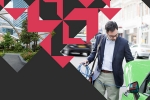Today, everybody is talking about being human-centred. It sounds natural and organic, so how can an organisation with any shred of decency not argue for being more human-centred? But what does it actually mean?
Any human endeavor is human-centered. In business, every organisation is fundamentally seeking to meet some human need, so why does the concept of being human-centred sound so innovative and exciting? The answer is that while all the people involved in organisations are of course humans, the activity of most organisations has historically categorised these various 'humans' into clearly defined buckets: 'stakeholders', 'customers', employees’, and countless other labels. Categorising and otherwise organising is what organisations do...they need specificity and structure. The humans in each of these buckets are expected to not only adhere to clearly defined parameters, but also have clearly defined expectations set by the organisation that can then be measured and managed.
So, why is human-centricity so revolutionary? Firstly, it challenges the familiar conventions that organisations are designed to deal with. In seeking to organise, they de-humanise rather than seek to connect with the very humans that are the heart of their business.
Activist shareholders, empowered customers, volatile consumers, and rebellious employees were never imagined in the organisation defined by the industrial revolution. While stop-gap measures have been created to address the disruption they create, these were all measures to bring people back into the accepted framework and create harmony in an environment that they perceived to be chaotic.
But in today’s disruptive environment, these control measures have stopped working...what are organisations to do?
Enter the human-centred revolution...
Human-centred means to genuinely focus on the humans who are at the heart of what the organisation does. Inevitably, there are many people who are impacted by the business of most organisations, which means that organisations need to re-conceptualise the groups they serve. While there are many variations that need to be considered based on the given organisation, there are three broad categories that today's businesses need to focus on:
- Community Impact – the value that organisations create in the communities they operate in (this is increasingly being recognised through ESG measures).
- Employee Experience – true employee engagement that goes beyond improved working experience, but rather co-creation and sense of mutual ownership for the success of the organisation.
- Customer Focus – despite being recognised as critical, most organisations still don’t really prioritise their customer or end-users, and yet partnering with ‘consumers’ has be demonstrated time and again to yield some of the greatest organisational benefit.
In order to respond to all of these different groups, organisations need to undergo a human-centred transformation. A simple way to conceptualise this is by thinking of organisations as being made up of several parts as shown here:

In the pursuit of transformation, businesses have traditionally sought to change individual parts with a focus on changing the ‘Organisation’ or ‘formal’ part as this is perceived as easier (e.g., restructure, tech implementation, etc) with the ‘People’ let alone ‘Individual’ parts being left as afterthoughts. But as complex adaptive systems, they need to evolve as a whole from the inside-out (rather than the more conventional outside-in). Fortunately, a red thread runs through all of these systems - a sort of DNA that guides evolution at all levels of complexity:
- Mindset - The mindset each individual brings to the system.
- Culture - The manifestation of the dominant mindset.
- Purpose - The articulation of the system’s ‘raison d’etre’.
- Society - The expectation of the environment / ecosystem.
Each of these influences the other, as individual mindsets coalesce to create a shared culture, which influences the organisational purpose in line with society’s expectations. The reverse is also true. The advantage is that by shifting mindsets, you can evolve the entire system. The disadvantage is that barriers in any layer of the system will collapse the transformation.
For most organisations, being genuinely human-centred represents a radical mindset shift. Shareholders, employees and customers all have unique needs and expectations that now need to be fulfilled in ways that were never previously imagined. The reality is that being human-centred is uncertain and complicated, especially without a clear roadmap...but there is a secret - those who seek to truly understand the 'humans' that permeate their business and tailor their approach accordingly will not only survive the revolution...but thrive!
Fundamentally, organisations require a mindset shift…
Stay tuned for the next article in this series where we’ll explore the mindset shift people and organisations need to undergo and what that involves.
Contact us
















